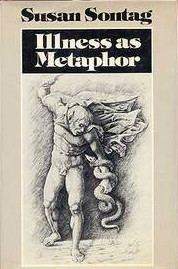7.8 /10 1 Votes7.8
Country United States Publication date 1978 ISBN 978-0-374-17443-9 Originally published 1978 Page count 87 Publisher Farrar, Straus and Giroux | 3.9/5 Goodreads Language English Pages 87 OCLC 299370676 Genre Treatise | |||||||||||||||||||||||||||||||||
 | ||||||||||||||||||||||||||||||||||
Subjects Cancer, Tuberculosis, Disease, Social stigma, Metaphor Similar Susan Sontag books, Cancer books | ||||||||||||||||||||||||||||||||||
A review of susan sontag s illness as metaphor
Illness as Metaphor is a 1978 work of critical theory by Susan Sontag, in which she challenges the victim-blaming in the language often used to describe diseases and those who suffer from them.
Contents
Drawing out the similarities between public perspectives on cancer (the paradigmatic disease of the 20th century before the appearance of AIDS), and tuberculosis (the symbolic illness of the 19th century), Sontag shows that both diseases were associated with personal psychological traits. In particular, she says that the metaphors and terms used to describe both syndromes lead to an association between repressed passion and the physical disease itself. She notes the peculiar reversal that "With the modern diseases (once TB, now cancer), the romantic idea that the disease expresses the character is invariably extended to assert that the character causes the disease–because it has not expressed itself. Passion moves inward, striking and blighting the deepest cellular recesses." Sontag says that the clearest and most truthful way of thinking about diseases is without recourse to metaphor.
She believed that wrapping disease in metaphors discouraged, silenced, and shamed patients. Other writers have disagreed with her, saying that metaphors and other symbolic language help affected people form meaning out of their experiences.
Context
Sontag wrote the treatise while being treated for breast cancer. She does not mention her personal experience with cancer in the work, but she addresses it in her related 1988 work, AIDS and Its Metaphors.
At the time that Sontag was writing, the current alternative cancer treatment fad was psychotherapy for the patient's supposed "cancer personality". According to these proponents, patients brought cancer upon themselves by having a resigned, repressed, inhibited personality. By undergoing the often blame-filled psychotherapy offered by some groups, such as the Simonton Center, the patient would overcome cancer by consciously choosing to give up the emotional benefits he or she created the cancer for, and be healed. Others have taken her idea further, showing not that there is a real "cancer" behind the metaphors, but that all we have is metaphor—even in science—to understand the behavior of a disease that remains mysterious.
Publication
The short book was originally published as three long essays in the New York Review of Books. Some of the more inflammatory language was slightly toned down when it was published as a book. For example, what Sontag originally called the "inimitable looniness" of Wilhelm Reich's language was softened to the "inimitable coherence".
Reception
Illness as Metaphor has been regarded as one of Sontag's widest read and most celebrated works. Kirkus Reviews called it "a small, liberating book that could become the cancer patient's Common Sense." The literary critic Denis Donoghue of The New York Times gave the book mixed praise, describing it as "a deeply personal book pretending for the sake of decency to be a thesis." He added:
As an argument, it seems to me strident, unconvincing as it stands, a prosecutor's brief that admits nothing in defense or mitigation. The brief is too brief to be just. So the reader is left with a case not fully made but points acutely established; enough, at any rate, to make him feel not only that he must in future watch his language but, with the same vigilance, watch his attitudes, prejudices, spontaneities.
Conversely, the literary critic and frequent Sontag detractor Camille Paglia described the book as "clumsy and ponderous, like a graduate-school seminar paper."
